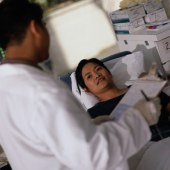| 
'Hospitalist' Physicians Help Shorten Patient Stays
 THURSDAY, Dec. 20 (HealthDay News) -- A new breed of medical specialists, called hospitalists, can make a small but significant difference in shortening how long a patient needs to stay in the hospital, a new study shows.
The 2002-2005 study of almost 77,000 hospital stays at 45 centers showed that treatment by a hospitalist, rather than a general internist, resulted in about a half-day reduction in overall hospital stays on average, along with an average $268 drop in costs.
At the same time, researchers found no difference in the rate of either patient death or readmission when hospitalists were involved, according to the report in the Dec. 20 issue of the New England Journal of Medicine.
A hospitalist refers to a physician who cares solely for hospitalized patients.
The term may be new to the general public, but, in the medical profession, "hospitalist has been a recognized and accepted term that has been around for about a decade," said study author Dr. Peter K. Lindenauer, an associate professor of medicine at Baystate Medical Center and Tufts University, in Boston.
In fact, "There is a Society of Hospital Medicine with 5,000 to 10,000 members, and it is estimated that there may be 20,000 hospitalists across the United States now," Lindenauer said.
"What you can't debate is the number of hospitalists around the country -- there is no going back," added Dr. Laurence McMahon, chief of the division of general medicine at the University of Michigan, in Ann Arbor.
"We need to think about how these new doctors get into the health-care system and how they care for patients who are hospitalized," said Mcmahon, who also authored an accompanying editorial on the issue.
Traditionally, a person's private physician has been responsible for care after hospitalization, he said. That began to change about 30 years ago, with the emerging role of emergency room physicians and critical care physicians, Lindenauer said. "They have been assuming the role of attending physician in those situations," he said. "In some respect, the growth of the hospitalist model of care represents the completion of a series of steps toward specialization that began 30 years ago."
According to Lindenauer, the advent of the hospitalist means another question should be asked when individuals choose a private physician: Will that doctor turn over care to a hospitalist, if and when someone needs hospital care?
"It is a discussion that a patient should have with a primary-care physician when he is thinking about enrolling with that physician," Lindenauer said.
The differences shown in the study -- a shortening of length-of-stay by 0.4 days, on average -- are not great, he acknowledged, but they do add up over time.
"Shortening the length of stay by 0.4 days is small, but when you multiply it out over time by thousands of physicians, the effects can be very large. With 5,000 cases a year, [that's] a savings of 2,000 bed-days," he said.
The study was not able to assess patient satisfaction with treatment by a hospitalist rather than a primary-care physician, Lindenauer said, "But we know that efficiency is important, as important to patients as to physicians." he said.
And while full official recognition of the hospitalist speciality is yet to come, the Society of Hospital Medicine is working closely with the of American Board of Medical Specialties toward such an end, Lindenauer said.
"The differences between hospitalists and other doctors who take care of patients in hospitals are pretty minor," McMahon said. "What really is quite revolutionary is the change in how we take care of patients in the hospital."
More information
There's more on hospitalists at the Society of Hospital Medicine  . .
|  |

Busting Medical Myths Even Doctors Believe

THURSDAY, Dec. 20 (HealthDay News) -- Somewhere in the back of your mind is the idea that you should drink at least eight glasses of water a day to stay healthy.
You may have nodded in agreement when someone mentioned scientific studies showing that, on average, you use just 10 percent of your brain.
And you may have lectured your children about the danger of reading in dim light, which could cause permanent eye damage.
None of this is true. But the ideas continue to circulate (and be believed even by some physicians), say Drs. Rachel Vreeman and Aaron Carroll of the Indiana University School of Medicine. They've taken the time and trouble in a two-page report in the Dec. 22-29 British Medical Journal to puncture seven such medical myths.
"We picked these in particular, because we either heard physicians repeat them or heard them in the media a number of times," said Vreeman, who is a fellow in children's health services research at Indiana. "They do appear to be ingrained in the popular imagination, including that of physicians."
Dr. Graham F. Greene, associate professor of urology at the University of Arkansas for Medical Sciences College of Medicine, admits he was tempted to believe the 10 percent brain myth, especially because he'd heard it attributed to Albert Einstein (not so), even though Greene is involved with the UAMS Web page devoted to puncturing similar myths.
"But, in reality, the brain is still a huge mystery in terms of capacity," Greene said. "We're still learning about it."
Greene does recall hearing his mother caution his sisters about another myth punctured in the BMJ presentation -- that shaved hair will grow back coarser and darker. The myth persists even though controlled studies done as long ago as 1928 showed no difference in the growth and texture of shaved and non-shaved hair.
Then, there's the one about hair and fingernails continuing to grow after death -- the so-called Dracula effect. What actually happens, Vreeman and Carroll write, is that the skin retracts after death, giving the illusion of growth. That's part of something that happens during life, too -- you grow "long in the tooth," not because old teeth are growing, but because the gums that support them shrink.
There's an air of scientific verisimilitude about another myth cited by Vreeman and Carroll -- that eating turkey makes you sleepy. Supposedly, that happens because turkey is rich in the sleep-inducing amino acid tryptophan, but the tryptophan content is not great enough to bother anyone, Vreeland said. It's probably the wine that comes with the Thanksgiving turkey that lowers the eyelids.
As for drinking eight glasses of water a day, don't try it. Water comes into the body via a number of foods, such as fruits and vegetables, and a zealous endeavor to meet the eight-glass quota might even be dangerous, Vreeman said.
She and Carroll are expanding their myth-busting effort. "We're in the process of writing a book with over 100 of them," Vreeman said.
Have you heard the one about chewing gum staying in your stomach for seven years if you swallow it?
More information
For a clear-eyed take on other medical myths, visit the University of Arkansas for Medical Sciences  . .
|  |

Smokers' Brain Centers Activate During Nicotine Cravings
WEDNESDAY, Dec. 19 (HealthDay News) -- Specific areas of the brain show increased activation in smokers who are deprived of nicotine, says a University of Pennsylvania study.
The finding may boost understanding of cigarette cravings, a key risk factor for relapse among people trying to kick the habit, the researchers said.
"There have been several brain imaging studies showing how subjects respond to visual, smoking-related cues, such as a picture of a cigarette or of someone smoking," senior study author Caryn Lerman, director of the Transdisciplinary Tobacco Use Research Center, said in a prepared statement. "However, less is known about the neural basis of urges that arise naturally as a result of nicotine deprivation. This study was designed to help fill this research gap."
The study included 15 regular smokers whose brain blood flow was measured on two separate occasions. The participants had a cigarette within an hour of having the first brain scan, and then abstained from smoking overnight before the second scan.
The results showed that cravings to smoke are associated with increased activation in brain regions that play a role in attention, behavioral control, memory and reward.
"The craving assessments used in our study predict relapse in smoking-cessation treatment. If validated in larger studies, these results may have important clinical implications. For example, perfusion MRI may aid in the identification of smokers at increased risk for relapse who require more intensive therapy," Lerman said.
The study is published in the Dec. 19 issue of The Journal of Neuroscience.
More information
The American Cancer Society offers a guide to quitting smoking  . .
|  |

Genetics May Boost Mexican-Americans' Risk for Alcoholism
THURSDAY, Dec. 13 (HealthDay News) -- Mexican-Americans carrying what's known as a haplotype of a particular gene may be at increased risk of alcoholism, a new study finds.
Haplotypes are clusters of genetic polymorphisms or variations.
In the study,researchers at the University of Kansas Medical Center (UKMC)collected blood samples and clinical data from almost 700 Mexican-Americans (334 alcoholics and 365 non-alcoholics) living in the Los Angeles area.
They focused particularly on the CYP2E1 gene, and found that people "carrying haplotype H6, the combination of the four alleles [copies] -- 1C, c2, C and A2 -- appear to have increased susceptibility to developing alcoholism," corresponding author Yu-Jui Yvonne Wan, a professor of pharmacology and director of the Liver Center at UKMC, said in a prepared statement.
Wan also said that hapoltype H6 is associated with late-age onset of drinking, as well as heavy drinking. They also found that the H1, H2 and H3 haplotypes were associated with alcohol consumption and smoking.
More research is needed to examine the "functional significance" of the H6 haplotpye.
"Whether H6 changes enzyme activity or alcohol-induced enzyme activity needs to be examined," Wan said. "Although only 5 percent of Mexican alcoholics have the H6 haplotype, it is important to use the same approach to study other ethnic groups, particularly Asians, who have high frequency of both c2 and C alleles. Furthermore, since elevated CYP2E1 causes oxidative stress, polymorphisms of this gene might also have an impact on other disease processes such as cancer."
The study is published in the December issue of Alcoholism: Clinical and Experimental Research.
More information
The American Academy of Family Physicians has more about problem drinking  . .
|  |
|